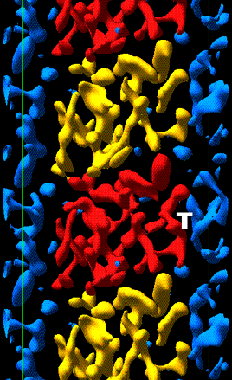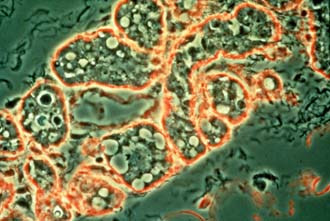




 |
 |
 |
 |
 |

|
This atomic-scale image created at Berkeley Lab shows where a molecule of the anti-cancer drug taxol (T) attaches itself to a protein molecule and prevents the cancerous host cell from dividing. Taxol is a natural substance from the rare Pacific yew tree which has been shown to be an effective treatment for a number of cancers. |
 For example, no malignancy affects more of this nation's women than breast
cancer, and none is more lethal to those between the ages of 40 and 45. Each year
approximately 182,000 American women develop the disease and each year
approximately 46,000 die from it. Berkeley Lab scientists have shown a direct
link between the development of breast cancer and a network of fibrous and
globular proteins surrounding breast cells called the extracellular matrix or
ECM. This on-going research has not only led to increased understanding about how
breast cancer starts and spreads, it has also resulted in the development of a
research tool that will be valuable to future breast cancer studies. The tool is
a three-dimensional assay for distinguishing normal from malignant human breast
cells in culture, a distinction that in the past has been extremely difficult to
make.
For example, no malignancy affects more of this nation's women than breast
cancer, and none is more lethal to those between the ages of 40 and 45. Each year
approximately 182,000 American women develop the disease and each year
approximately 46,000 die from it. Berkeley Lab scientists have shown a direct
link between the development of breast cancer and a network of fibrous and
globular proteins surrounding breast cells called the extracellular matrix or
ECM. This on-going research has not only led to increased understanding about how
breast cancer starts and spreads, it has also resulted in the development of a
research tool that will be valuable to future breast cancer studies. The tool is
a three-dimensional assay for distinguishing normal from malignant human breast
cells in culture, a distinction that in the past has been extremely difficult to
make.
 For women with metastatic breast cancer, few developments in chemotherapy
have stirred higher hopes than the recent approval by the Food and Drug
Administration of taxol, a drug derived from the bark of the Pacific yew tree
that has been shown to effectively curtail the spread of malignancy. The downside
has been a rise in heart toxicity. Experts say that a safer and even more potent
form of taxol could be synthesized if scientists had sufficient knowledge of how
the taxol molecule interacts with vital cell proteins to fight cancer. A major
step toward this goal was taken this past year when scientists at Berkeley Lab
produced an atomic-scale, high-resolution, three-dimensional image of the site
where taxol interacts with its target. They expect this year to construct an
atomic model of the interaction site that will enable drug companies to design
new and improved versions of taxol.
For women with metastatic breast cancer, few developments in chemotherapy
have stirred higher hopes than the recent approval by the Food and Drug
Administration of taxol, a drug derived from the bark of the Pacific yew tree
that has been shown to effectively curtail the spread of malignancy. The downside
has been a rise in heart toxicity. Experts say that a safer and even more potent
form of taxol could be synthesized if scientists had sufficient knowledge of how
the taxol molecule interacts with vital cell proteins to fight cancer. A major
step toward this goal was taken this past year when scientists at Berkeley Lab
produced an atomic-scale, high-resolution, three-dimensional image of the site
where taxol interacts with its target. They expect this year to construct an
atomic model of the interaction site that will enable drug companies to design
new and improved versions of taxol.
 In an effort to provide an earlier and more effective diagnosis of breast
cancer, Berkeley Lab scientists at the Center for Functional Imaging are
collaborating with a medical firm in the development of new and improved magnetic
resonance imaging (MRI) mammography. Able to detect the small tumors that x-ray
mammography frequently misses, and, in addition, able to identify tumors through
the dense tissue of larger breasts, current MRI mammography techniques have been
deficient in their ability to distinguish benign from malignant tumors. The MRI
technology now being developed at Berkeley Lab will enable physicians to perform
needle biopsies of detected tumors while the patient is being imaged.
In an effort to provide an earlier and more effective diagnosis of breast
cancer, Berkeley Lab scientists at the Center for Functional Imaging are
collaborating with a medical firm in the development of new and improved magnetic
resonance imaging (MRI) mammography. Able to detect the small tumors that x-ray
mammography frequently misses, and, in addition, able to identify tumors through
the dense tissue of larger breasts, current MRI mammography techniques have been
deficient in their ability to distinguish benign from malignant tumors. The MRI
technology now being developed at Berkeley Lab will enable physicians to perform
needle biopsies of detected tumors while the patient is being imaged.

|
Berkeley Lab researchers are studying the role of the extracellular matrix (ECM) in breast cancer. Shown here by an orange stain, the ECM is a network of fibrous and globular proteins that surround and support breast cells. Breakdowns in the ECM have been linked to the development of malignancies. |
 Mutation of a gene called BRCA1 has been identified as one source of breast
cancer in women, which adds it to the list of thousands of breakdowns in the
genetic code that are known to result in disease or other harmful health effects.
For this reason, deciphering the human genetic code has been called the "Holy
Grail of Biology," and to this end a nationwide effort called the Human Genome
Project (HGP) was launched. Berkeley Lab, as host to one of three human genome
research centers established by DOE, is a major participant in the project.
Mutation of a gene called BRCA1 has been identified as one source of breast
cancer in women, which adds it to the list of thousands of breakdowns in the
genetic code that are known to result in disease or other harmful health effects.
For this reason, deciphering the human genetic code has been called the "Holy
Grail of Biology," and to this end a nationwide effort called the Human Genome
Project (HGP) was launched. Berkeley Lab, as host to one of three human genome
research centers established by DOE, is a major participant in the project.

| 
| 
| 
|